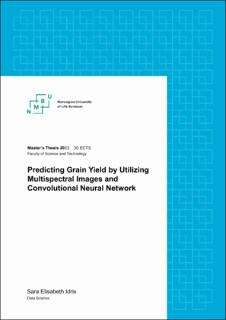| dc.description.abstract | According to the UN’s sustainability goals, hunger should have been eradicated by 2030, but the number is going the wrong way, with around 800 million people who suffer from undernourishment in 2022. Therefore, there is a pressing need to pro- duce more food with fewer resources while minimizing crop losses. A combination of remote sensing and deep learning can contribute to more efficient phenotyping of plants. Aerial photography is an excellent alternative to traditional manual or mech- anical plant health assessments. By applying remote sensing technologies, drones are now economically feasible to capture multispectral images of fields. The use of deep learning algorithms, such as Convolutional Neural Networks (CNNs), allows for the simultaneous analysis of large areas, significantly saving time. This research examines multispectral unmanned aerial vehicle imagery to extract essential features for wheat yield prediction in wheat breeding programs in NMBU at Ås. The thesis dataset comprises two fields with crops, each with eight multispectral images for each field, with five bands each (red, green, blue, near-infrared, and red-edge).
In this thesis, two simple CNN models with different architectures were utilized. The different combinations of datasets were trained using the two CNN architectures. The most effective model was the model, which included additional variables, such as days to heading and fertilization level, has enhanced the model’s predictive accuracy. This thesis employs a CNN to predict grain yield by utilizing all spectra recorded for each plot. The results suggest that this approach is satisfactory when predicting wheat grain yield.
Unlike similar studies, this thesis takes a different approach by utilizing the entire plot as a multispectral image, which allows for extracting all spectra recorded for each plot. Previous studies have used the median value of the plots to make predic- tions and have not incorporated CNN as part of their methodology. The resultant CNN model achieved an R2 score of 0.885. | |
